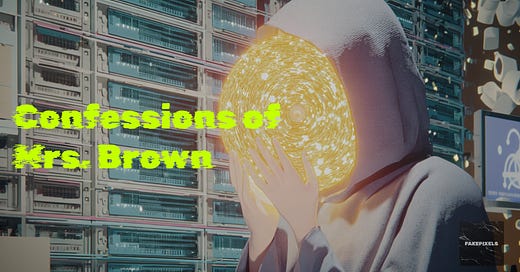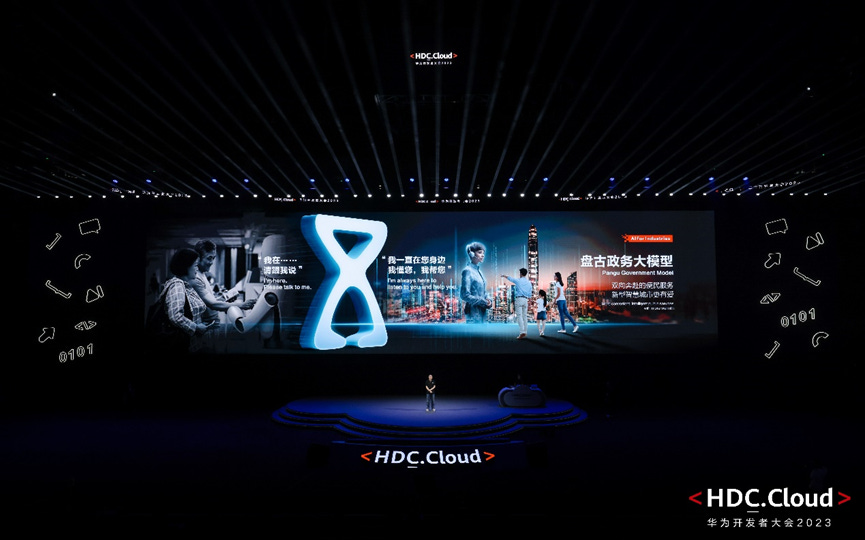"You cannot buy the revolution. You cannot make the revolution. You can only be the revolution. It is in your spirit, or it is nowhere." — Ursula K. Le Guin.
At a birthday dinner not long ago, I posed this question to the friends gathered round: “What has recently cracked you open?”
I was blessed with some mind-expanding answers, but my friend Yondon specifically surprised me by referencing an Ursula K. Le Guin essay, "Science Fiction and Mrs.Brown," a meditation on the inner life of Mrs. Brown, a half-imagined woman on a train, conjured from a chanced encounter with a stranger by the iconic writer Virginia Woolf.
First delivered as a lecture in 1975 and later enshrined in The Language of the Night, Le Guin’s piece draws on Mrs. Brown—Woolf’s emblem for the unquenchable spark of humanity in her seminal essay Mr. Bennett and Mrs. Brown—to interrogate science fiction itself: amid its vast galaxies and ingenious devices, can it still grasp the textured contradictions of a single soul? Or does it surrender the intimate “subject” to mere edifice and idea, forsaking the quivering heart at every tale’s core?
Le Guin wrote:
"I believe that all novels begin with an old lady in the corner opposite. I believe that all novels, that is to say, deal with character, and that it is to express character—not to preach doctrines, sing songs, or celebrate the glories of the British Empire, that the form of the novel, so clumsy, verbose, and undramatic, so rich, elastic, and alive, has been evolved. […] The great novelists have brought us to see whatever they wish us to see through some character. Otherwise, they would not be novelists, but poets, historians, or pamphleteers."
In the haze of that celebratory day, her argument hit differently: the root of great science fiction isn't escapist imagination, but the discipline of observation. Arrakis, Gethen, even the galactic archipelago of Trantor and the Foundation worlds aren't memorable and endurable just because of the spectacle. They persist because their inhabitants pulse with contradiction and texture; every invented custom, political system, or climate is filtered through the nervous system of someone real. The galaxies and spaceships are scaffolding. What sticks is the raw, subjective ache of a person wrestling entropy. The grandeur of the imagined only matters to the extent it sharpens our focus on the subject at its core.
Le Guin's insight is as much a challenge as a comfort. It's easier, especially for founders, for technologists, for anyone trying to pull the future forward, to believe in the mythology of invention: you imagine radically, and then you build. But Woolf, and Le Guin after her, asks: what good are all your objects, your inventions, your universes, if there's no subject at the center? What's a new world worth if Mrs. Brown herself never appears, whole and trembling, on the page?
Today's Mrs. Brown
But what does it really mean, in a world obsessed with invention and speed, to "see" the subject? What does it cost, psychologically, structurally, to resist the economic and technological pressure to build for universality, scale, and abstraction?
Abstraction seduces with its ease. It comforts, beguiles. It spares effort, swells effortlessly, distilling the world’s wild tangle into neat cells for ledgers. As Byung-Chul Han wrote in Non-Things:
"The digital world is a world without smell, without taste, without touch, without pain. It is a world without ritual, without event, without memory. It is a world without friction." This frictionlessness, Han claims, leads to a "crisis of presence," a flattening of experience into sameness.
This indictment cuts straight to the heart of Silicon Valley’s love for detachment and device. Countless ventures erupt with flawless presentations and gleaming trajectories, engineered for some nebulous “vision,” oblivious to the Mrs. Browns hovering at the edges. The lure is spectacle, novelty masquerading as revelation. But transformative tools arise from reverent vigilance toward the already vital and breathing.
Le Guin’s fire burns not in her conjured structures, but in her unyielding devotion to the raw human, the specter that stalks every contrived emptiness.
Founders as sci-fi writers
It's not uncommon to analogize modern founders as sci-fi writers; that's why we frequently see "manifestos" on company sites, a preface of sorts that anchors the prospective readers (the customers and potential hires) to situate essential properties of the world that is about to be introduced. Great founders build great worlds that are nothing short of science fiction. That can obviously be true for Musk, who epitomizes such an archetype, but it can equally be true for the founder of a database company.
At their best, founders mirror Le Guin: patient observers, building on truths gleaned from long study of real needs, idiosyncratic people, local pain. At their worst, they are set designers on a cosmic soundstage, swapping in new props and hoping meaning emerges from machinery alone. This echoes the lament of the talented designer Jason Yuan, who recently observed on X: "what a time: an abundance of capital and tech and optimism .. strangled by a poverty of imagination."
Contrary to common belief, most world-building vision actually stems from a maniacal focus on one specific unit of obsession.
Frank Herbert’s Dune exemplifies such craft. Beneath its colossal worms, flying craft, and cosmic hierarchies pulses a meticulous weave of environment, faith, authority, and lineage. Herbert delved for years into arid biomes, raising his edifice grain by grain. Arrakis’s intrigues circle eternally around water: its dearth, dominion, ceremony, sorrow. Imperial vastness invariably circles back to the particular and palpable.
I think often of a scene in which a founder gestures to a diagram on the deck labeled "Human-in-the-Loop," and I was curious about the actual human in the loop: a worker in Manila, eyes straining at cheap monitors, improvising fixes for a dataset full of contradictions. Who, in the sleekly designed deck, is Mrs. Brown?
The real power of observation isn’t just a moral challenge, but a strategic imperative. Building for the “blurred edge,” Mrs. Browns, the users who contradict any clean-cut persona, is what makes systems resilient. Businesses that survive the volatility of scale are those willing to trace the pattern to its source, even when it leads to the counterintuitive or the overlooked.
The true story of Pangu
In Shenzhen, a man lay sleepless, crushed beneath pilfered lines of code, each a mute accusation, every midnight alert a call from an estranged reality. His laptop, lingering warm at his side, spilled a dim, reproving light, bearing witness to purpose’s slow decay.
His hands, once as steady as code itself, now trembled above the keyboard, twenty-seven years of muscle memory short-circuited by something that had nothing to do with fear of being caught, but the quiet betrayal of one's dignity and purpose.
This is the imagery I conjured in my head when reading the lacerating confession from the whistleblower within Huawei's Pangu foundation model team, a document composed in the dead of the night, tears smudging lines between reminiscence and rage.
"I have been tossing and turning every night and having trouble falling asleep," the anonymous insider confesses. "This kind of repression and humiliation has gradually worn away my feelings for Huawei, making my time here gradually muddle-headed, confused, and often doubting my life and self-worth." He admits, "I am a coward," terrified of losing his job, yet driven to speak.
Pangu, Huawei's audacious bid to forge "the world's second choice" in foundation models, ignited with fervor. Engineers forfeited weekends, family bonds, even months in Suzhou isolation camps, Saturdays defaulted to grueling work, sweetened only by occasional crayfish and afternoon tea, for a cause cloaked in nobility. "We are really burning our youth to polish the domestic computing power base," he writes, evoking the sacrifices: "Living in a foreign city, we gave up our families, vacations, health, entertainment, and sacrificed our lives."
But cracks emerged. Early models, trained on limited computing power, faltered. The 135B, meant as a triumph, was hobbled by a tokenizer so archaic that "each single symbol, number, space, and even Chinese character would occupy a token," wasting resources and yielding poor results. Genuine innovations languished, while the other internal lab’s "breakthroughs" materialized overnight. The revelation: they were essentially cloning competitors. For the new model, they "actually used Qwen 1.5 110B to continue training," adding layers and tweaks to masquerade as original, with parameter distributions almost the same and even the class name of the model code was Qwen at the time, and they were “too lazy to even change the name."
Leadership, possessed of a willful ignorance, nodded sagely at "ten points across all metrics," mistaking forgery for breakthrough. The digital equivalent of art theft, Qwen 1.5's 110B parameters, stretched and disguised, paraded as native genius, was rewarded, while genuine invention was quietly buried.
Now resigning as he writes, he seeks atonement: "Having signed on these technical reports is a stain that I will never be able to erase in my life…if I disappear, it can be considered that I sacrificed myself for the truth and ideals."
Mrs. Brown once again speaks, not as an abstraction. Her voice echoes across borders, a reminder that AI's arms race devours personal ideals indiscriminately, from Suzhou to Silicon Valley. Even in China, often critiqued for systemic invasions of IP and originality, an engineer's sacred dignity in their own work endures, at least within themselves, fueling such a raw and painful confession.
The Stubborn subject
This is what we rarely acknowledge when efficiency becomes the sole plotline, when we hail the falling cost of compute, trace "the end of human operating expense," or build models designed to abstract away labor. The story, as usually told, veers easily into moralizing: technology replacing people, platforms extracting value, Mrs. Brown consigned to a footnote. But there's a subtler danger in centering only loss or only sympathy.
Mrs. Brown is not just a symbol for the displaced. She is also the improviser, the adapter, the one who finds within techno-capitalism new forms of leverage, a way to leap across boundaries, to earn, to transform her trajectory and that of her family. In places where the platform economy or distributed labor offers more freedom than the village or the factory ever could, critique from a distance, especially from a place of privilege, can flatten intent as much as abstraction does.
To truly see Mrs. Brown is not to enshrine her as victim, nor to glorify "resilience" as a feel-good metric. It is to let improvisation and exploitation, constraint and freedom, loss and agency, all tangled together. We miss the point if we only grieve the jobs or celebrate the gains. The only real error is in assuming there is ever just one story to be told.
There's something almost alchemical about the way Mrs. Brown keeps slipping back in — as the anonymous bug report, the unexplained spike in a dashboard, the stubborn edge case that resists automation, the off-color joke that slips past the LLM's filter. Platforms might yearn for labor to become universally fungible, infinitely updatable, and completely replaceable. Yet again and again, the most essential work proves itself stubbornly local, full of contradiction and context, flickering through the cracks of every abstraction, refusing to disappear.
And what of the so-called "builders above the LLM" who wield platforms instead of simply feeding them? Even here, the "subject" erodes: you slide toward becoming an API endpoint in someone else's schema, your edges and voice softly sanded down.
The recursion is relentless: at some layer, in some meeting or migration or late-night call. We are all, at least for a moment, Mrs. Brown.
What good are all the objects?
Every technologist should be haunted by Le Guin's dangerous question: "What good are all the objects in the universe if there is no subject?"
It's easy to analyze geopolitics and technological arms races at the level of nations and models, to speak in terms of "capabilities" and "regulatory arbitrage." It's infinitely more complex, and as urgent, to tell the stories of subjects: individuals with pride and shame, with families they hope to protect, with secrets they never meant to leak.
Why is this inversion so hard? Ironically, the local resists measurement. Mrs. Brown rarely shows up in the metrics that drive a product roadmap or a national GDP. To see her, one needs slow attention. One needs the discipline to sit in the complexity, to resist the drive to "close the ticket," "satisfy the metric," or "ship the feature" by rounding away the rough contour of the subject.
We keep trying to engineer Mrs. Brown away, and every new world we build, her shadow grows larger. The more frictionless our systems become, the more haunting her absence feels. Friction, interruption, error: these are not always signs that the system failed, but signals that the subject is still in the room.
Maybe the only real test of a new world, technological, narrative, or otherwise, is whether Mrs. Brown feels real enough to write a confession that cracks the system open. The future, whenever it arrives, will be built from the inside out. And suppose those creating it aren't allowed to remain human, to feel pride, shame, exhaustion, and the courage to speak truth. In that case, it will collapse under its own frictionless weight, leaving only mechanical abstractions and the ghosts of the subjects it consumed.
In the end, as Le Guin knew, the revolution begins not with code or conquest, but with the quiet act of seeing of being the subject who trembles and demands to be seen.
Note: For those seeking the full context and texture of the whistleblower’s confession, I encourage reading the original document. Consider using your browser’s translation feature or an LLM to access the testimony in its own words.









